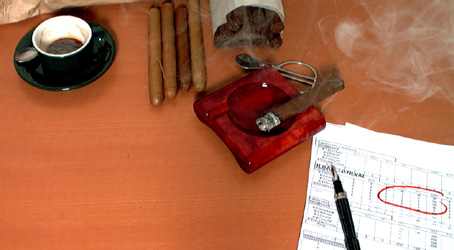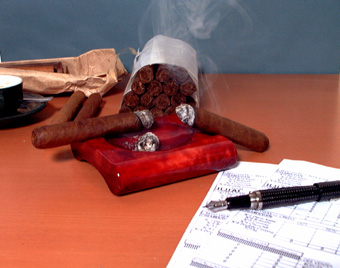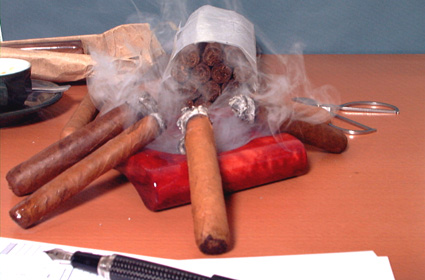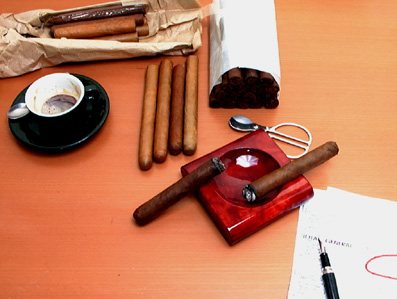Cigar-tasting
therefore means smoking the cigar and smoking takes time; depending on the
type of cigar the entire session may last fifteen minutes or more than an
hour, and at each stage of the tasting session the characteristics of that
stage must be noted.
We will therefore return to the tasting we began earlier where we left off,
i.e. at the stage where the cigar is selected. We will now explain in detail
the various factors to be evaluated, defining the characteristic under scrutiny
and the vocabulary used to describe it.
Before lighting up:
1) Appearance
of the cigar
Shape: check the shape. If, like most cigars, the shape is cylindrical, check
the regularity of the cylinder.
Check the shape of the head: the head may be hemispherical, flattened, twisted
or pointed.
Check the cut of the foot: the foot may be cut at right-angles to the cigar
or it may be cut at an angle. Is there any tearing?
Rolling of the wrapper: has the wrapper been evenly rolled or are there any
cracks?
Appearance of the wrapper: check the colour for regularity and any variations
in colour with the successive windings. Check for any coloured blotches; check
the grain quality and the shiny or dull appearance.
2) Firmness in the hand
Check any differences in firmness along the cigar; a common fault when rolling
a cigar is to overfill the ends in order to close the cigar. Cigars with this
defect may be on the hollow side towards the middle.
The need or taste for smoking is related to the absorption of nicotine. The
nicotine reaches the brain after a maximum 10 to 15 minutes; an hour later
virtually all the nicotine is eliminated. The smoke from air-dried tobacco
(i.e. cigars and dark tobaccos) is alkaline; the nicotine passes into the
bloodstream through the walls of the mouth. There is no need to inhale. The
smoke from so-called "bright" tobaccos, on the other hand, is acidic
and smokers need to inhale the smoke to absorb the nicotine though the walls
of the bronchi.
Compactness: a good cigar should be firm, i.e. well-filled but pliant. An
over-firm cigar will be difficult to smoke while a flabby cigar will draw
too easily.
3) Taste and smell before lighting
The characteristic smell of a good cigar is its first attraction. The cigar-lover
should learn to prolong this pleasure and intensify it by holding the unlit
cigar in the mouth for a long time.
With the cigar cut, the smoker should gently smell the air that gradually
fills the nose and mouth with all the aromas of the tobacco. The exquisite
sensations experienced while "smoking raw" give vital information
as to the body and richness of the smoke once the cigar is lit. In addition,
these few minutes of contact with the hand and mouth prepare the cigar for
lighting.

Lighting up:
First
puffs:
1) Observe any feelings of irritation:
- on the tip of the tongue – burning sensation (rare)
- inside the cheeks – biting (fairly common)
- on the body of the tongue – harshness (rare)
- in the throat – acrid (very common)
2) Draw:
Draw is such an important factor in the pleasure experienced when smoking
that it should be judged in two different ways: indirectly in terms of the
compactness of the cigar, and directly in the mouth.
C) During the entire smoke:
1) Combustion: the regularity with which a cigar burns along its entire length
is one of its essential qualities. Irregular burning is a sign that the tobacco
is uneven. The shape of the burning surface is a sign of how well the cigar
has been made: in a perfect cigar this surface will be flat; the surface will
be convex if either the wrapper or the binder burns too fast. If the wrapper
or the binder burns too slowly, the burning surface will be concave; this
is an extremely serious defect. Some cigars may have a tendency to go out,
revealing insufficient overall combustibility.
2) Flavour: the tongue may detect the four fundamental flavours
- sweet: fairly rare
- salty: theoretically impossible
- acid: fairly common
- bitter: very common, particularly in certain varieties of tobacco, notably
those from Indonesia.
We would point out that a slight sweetish flavour may not be unpleasant. This
is, of course, a matter of personal preference; it is, however, also related
to the overall balance of sensations. Slight bitterness is usually acceptable,
even welcome; acidity, however, is always perceived as a defect.
3) Taste: overall judgement
The two main criteria are:
a) Richness determined by the variety and quality of the aromas. The words
"rich", "generous" or "heady" may be used to
describe a smoke with a wide range of aromas. These adjectives express the
richness and fullness of the aroma. The use of the word "heady"
to describe cigar smoke should not be confused with the same word used to
describe a wine: a "heady" wine is one that is high in alcohol,
i.e. a wine which "goes to your head". The opposite of a rich smoke
may be described as having an aroma that is "poor", "thin"
or "flat".
In an ideal world richness of aroma would be explained by analysing the chemical
composition of cigar smoke. Constituents such as terpenes and ketones, which
play an important role in perfumery, may be detected. Some of these substances
are also major irritants and may have a masking effect on flavours. But the
number and range of chemicals found in cigar smoke are so vast that accurate
analysis remains an impossible ideal – at least at the present time
.
But a trained "nose" can define olfactory impressions by detecting
notes in tobacco smoke that can be identified by referring to very pronounced
natural odours of which a list is given below. For obvious reasons this list
is not exhaustive.As
we have already pointed out, the odour transmitted by a chemically pure substance
may be perceived very differently depending on the level of concentration.
For example, a very slight trace of ammonia may be perceived as highly agreeable,
although not of course by everyone. Higher concentrations mixed with other
odours may evoke urine and cause a reaction of disgust – or indeed attraction
in some cases...
b) Intensity, which is a measurement of the density of olfactory substances
and nicotine in smoke. Words such as "filling", "full",
"warm", "" substantial", " full-bodied"
or "satisfying" may be used to express intensity, while its opposite
may be expressed as "hollow", "weak", "short",
"shallow" or "thin".
Other criteria are:
c) Character: a very personal judgement of the pleasing qualities of the smoke.
The smoke from a good cigar may be described as "elegant", "distinguished",
"graceful", "amiable", "stylish" or "racy",
while that from a poor cigar is "indifferent", "dull",
"flabby", "ordinary", "common"... even "vulgar"!
d) Balance: this is the supreme quality in a cigar whose various constituents
combine perfectly. Where balance is perfect the cigar may be described as
"harmonious", "mellow", "rounded", "flowing",
"complete", "balanced", "creamy" or "velvety".
Lack of balance may be described as "jarring", "heavy"
or "unbalanced".
e) Persistence: this word, borrowed from the perfume industry, is used to
describe the ability of an odour to prolong its presence. But no smoke is
capable of persisting without changing for the worse; and persistence combined
with intensity is a defect. Smoke should have "presence" but disappear
rapidly. In a word, discreetly.
4) Taste: analysing flavours
Returning to the analysis we gave earlier, we will repeat the main odours
present in smoke and those used to give the most accurate idea of the origin
of the tobacco:
Woody, plant notes:
DRIED GRASS
STRAW
DRY EARTH
MOWN HAY
MOSS
DAMP EARTH
TRUFFLES
CINNAMON
NUTMEG
Smells of animal origin:
STABLES
SHEEP
MUSK
LEATHER
Sweet and roasted smells
TAR
TOAST
COFFEE
CHICORY
COCOA.
CARAMEL
GINGERBREAD
HONEY
LIQUORICE
VANILLA
MILKY NOTES
Spices
PEPPER
CAPSICUM
PIMENTO
NUTMEG
CINNAMON
WHICH AROMAS ARE FOUND IN WHICH VINTAGES?
Tasting
notes on the main vintages of cigar tobacco are given later in the present
work. For the moment we will give a broad outline of the flavours listed above,
indicating which vintages and which cigars are normally characterised by them.
Plant odours:
These odours are present in the smell of tobacco and in the smoke of cigars
with a medium to weak body such as Dominican, light Cuban (mown hay), Manila,
Java (wet hay) with touches of eucalyptus and a variety of floral notes. The
degree of humidification has a significant effect on the nature and character
of plant sensations: if a cigar is too dry, its odours will tend towards smells
of straw or even paper; if it has been well humidified it will have rich floral
notes; if humidification has gone too far the smell will be of sour hay and
there will be a burning sensation.
Woody odours:
Closely related to plant odours, woody odours have a great olfactory presence
and a tendency towards plant juices, resins, saps and liquorice. They are
found in indigenous tobaccos known as "criollos" and their derivatives:
Olor dominicano, Honduran criollos tobaccos, the rather coarse tobaccos from
the Partido and Vuelta Abajo areas of Cuba.
Spicy odours:
Peppery notes are often present in tobacco and in unlit cigars. Hot pepper
is very present in the smoke of full-bodied Cuban cigars, sometimes mingling
with notes of green capsicum and nutmeg. From this point of view, Honduran
cigars are closely related to Havana cigars; in contrast, the presence of
pepper in Dominican cigars is often blended with honeyed sweetness.
Animal odours:
All the animal notes detected in cigars are as a result of ammoniated by-products
of fermentation. When fermentation is only partial the ammonia is too harsh
on the nose but in small quantities it produces rich odours of the stable,
sometimes of sheep or musk; the latter are very apparent in fine Havanas.
The classic cigars of Nicaragua as well as the coarser Cuban varieties have
these odours with a vengeance, sometimes accompanied by notes of camphor and
iodine. Some very refined cigars, particularly certain Cuban cigars in which
the body is not too full, have fine notes of leather-goods.
Sweet and roasted odours:
These odours come from the sugars present in the plant. Depending on the degree
to which they have been heated they can give off sweetish, even sickly, flavours
of honey, milky smells and an entire palette of odours ranging from caramel
to roasted, even toasted smells. Dominican cigars smell of gingerbread with
notes of vanilla and milk products while coarse Havanas evoke toast and chicory.
Honduran cigars can give of burnt smells while their Jamaican cousins can
evoke dairy products. And finally, Brazilian cigars evoke milky caramel and
cocoa.
Humus odours:
The smells of the earth that fed the plant give it a characteristic "earthy"
taste that is always somewhat "rustic" but never lacking in charm.
When Dominican cigars are made primarily with Olor Dominicano tobacco they
have a characteristic smell of mown hay. Coarse Cuban cigars have heavier
earthy smells while Honduran cigars often have an earthy taste that can become
too pronounced if the cigar is too dry. This last point holds good for all
cigars.

©"CIGAR. From initiation to mastery" by Gilbert Belaubre
